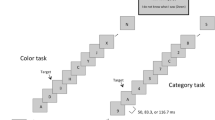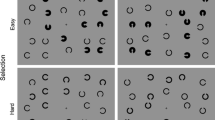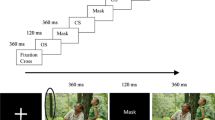Abstract
A number of studies have demonstrated that individuals with autism spectrum disorders (ASDs) are faster or more successful than typically developing control participants at various visual-attentional tasks (for reviews, see Dakin and Frith in Neuron 48:497–507, 2005; Simmons et al. in Vis Res 49:2705–2739, 2009). This “ASD advantage” was first identified in the domain of visual search by Plaisted et al. (J Child Psychol Psychiatry 39:777–783, 1998). Here we survey the findings of visual search studies from the past 15 years that contrasted the performance of individuals with and without ASD. Although there are some minor caveats, the overall consensus is that—across development and a broad range of symptom severity—individuals with ASD reliably outperform controls on visual search. The etiology of the ASD advantage has not been formally specified, but has been commonly attributed to ‘enhanced perceptual discrimination’, a superior ability to visually discriminate between targets and distractors in such tasks (e.g. O’Riordan in Cognition 77:81–96, 2000). As well, there is considerable evidence for impairments of the attentional network in ASD (for a review, see Keehn et al. in J Child Psychol Psychiatry 37:164–183, 2013). We discuss some recent results from our laboratory that support an attentional, rather than perceptual explanation for the ASD advantage in visual search. We speculate that this new conceptualization may offer a better understanding of some of the behavioral symptoms associated with ASD, such as over-focusing and restricted interests.
Similar content being viewed by others

Notes
It is important to note that an opposite trend, namely increased distractibility has also been reported in ASD. Burack (1994) tested a small group of extremely low-functioning (N = 12, mean IQ = 49.5) adults with ASD and suggested that there is a general selective attention deficit in autism. Many authors since this early report have demonstrated (e.g. Remington et al. 2009) evidence for the contrary. A general selective attention deficit is also in contrast with the findings of the large body of research on ASD advantage in visual search reviewed in this paper.
References
Almeida, R. A., Dickinson, J., Maybery, M. T., Badcock, J. C., & Badcock, D. R. (2010). Visual search performance in the autism spectrum II: The radial frequency search task with additional segmentation cues. Neuropsychologia, 48, 4117–4124.
Almeida, R. A., Dickinson, J., Maybery, M. T., Badcock, J. C., & Badcock, D. R. (2013). Visual search targeting either local or global perceptual processes differs as a function of autistic-like traits in the typically developing population. Journal of Autism and Developmental Disorders, 43, 1272–1286.
Anderson, C. J., & Colombo, J. (2009). Larger tonic pupil size in young children with autism spectrum disorder. Developmental Psychobiology, 51, 207–211.
Anderson, C. J., Colombo, J., & Shaddy, D. (2006). Visual scanning and pupillary responses in young children with autism spectrum disorder. Journal of Clinical and Experimental Neuropsychology, 28, 1238–1256.
Anderson, C. J., Colombo, J., & Unruh, K. E. (2012). Pupil and salivary indicators of autonomic dysfunction in autism spectrum disorder. Developmental Psychobiology,. doi:10.1002/dev.21051.
Ashwin, C., Wheelwright, S., & Baron-Cohen, S. (2006). Finding a face in the crowd: Testing the anger superiority effect in Asperger Syndrome. Brain and Cognition, 61, 78–95.
Aston-Jones, G., & Cohen, J. D. (2005). An Integrative theory of locus coeruleus-norepinephrine function: Adaptive gain and optimal performance. Annual Review of Neuroscience, 28, 403–450.
Aston-Jones, G., Iba, M., Clayton, E., Rajkowski, J., & Cohen, J. (2007). The locus coeruleus and regulation of behavioral flexibility and attention: Clinical implications. In G. A. Ordway, M. A. Schwartz, & A. Frazer (Eds.), Brain norepinephrine: Neurobiology and therapeutics (pp. 196–235). New York: Cambridge University Press.
Baldassi, S., Pei, F., Megna, N., Recupero, G., Viespoli, M., Igliozzi, R., et al. (2009). Search superiority in autism within, but not outside the crowding regime. Vision Research, 49, 2151–2156.
Baranek, G. T. (1999). Autism during infancy: A retrospective video analysis of sensory-motor and social behaviors at 9–12 months of age. Journal of Autism and Developmental Disorders, 29, 213–224.
Baron-Cohen, S., Wheelwright, S., Skinner, R., Martin, J., & Clubley, E. (2001). The Autism-Spectrum Quotient (AQ): Evidence from Asperger syndrome/high-functioning autism, males and females, scientists and mathematicians. Journal of Autism and Developmental Disorders, 31, 5–17.
Bayliss, A. P., & Kritikos, A. (2011). Brief report: Perceptual load and the autism spectrum in typically developed individuals. Journal of Autism and Developmental Disorders, 41, 1573–1578.
Beatty, J. (1982). Task-evoked pupillary responses, processing load, and the structure of processing resources. Psychological Bulletin, 91, 276–292.
Blaser, E., Eglington, L., & Kaldy, Z. (2012). Toddlers with ASD are better at visual search without trying harder: A pupillometric study. Poster presented at the Annual Meeting of the Vision Sciences Society, May 11-16, 2012, Naples, FL.
Blaser, E., Eglington, L., Carter, A. S., & Kaldy, Z. (2013). Pupillometry reveals a mechanism for the Autism Spectrum Disorder (ASD) advantage in visual tasks (submitted).
Bölte, S., Schlitt, S., Gapp, V., Hainz, D., Schirman, S., Poustka, F., et al. (2012). A close eye on the eagle-eyed visual acuity hypothesis of autism. Journal of Autism and Developmental Disorders, 42, 726–733.
Brock, J., Xu, J. Y., & Brooks, K. R. (2011). Individual differences in visual search: Relationship to autistic traits, discrimination thresholds, and speed of processing. Perception, 40, 739–742.
Bruckner, C., & Yoder, P. (2007). Restricted object use in young children with autism: Definition and construct validity. Autism, 11, 161–171.
Burack, J. A. (1994). Selective attention deficits in persons with autism: Preliminary evidence of an inefficient attentional lens. Journal of Abnormal Psychology, 103, 535–543.
Caron, M. J., Mottron, L. L., Berthiaume, C. C., & Dawson, M. M. (2006). Cognitive mechanisms, specificity and neural underpinnings of visuospatial peaks in autism. Brain, 129, 1789–1802.
Collignon, O., Charbonneau, G., Peters, F., Nassim, M., Lassonde, M., Lepore, F., et al. (2013). Reduced multisensory facilitation in persons with autism. Cortex, 49, 1704–1710.
Cook, J. (2012, November 29). The autism advantage. The New York Times Magazine. Retrieved from http://www.nytimes.com.
Dakin, S., & Frith, U. (2005). Vagaries of visual perception in autism. Neuron, 48, 497–507.
Darling, R. D., Alzghoul, L., Zhang, J., Khatri, N., Paul, I. A., Simpson, K. L., et al. (2011). Perinatal citalopram exposure selectively increases locus coeruleus circuit function in male rats. Journal of Neuroscience, 31, 16709–16715.
Dawson, G. (2008). Early behavioral intervention, brain plasticity, and the prevention of autism spectrum disorder. Development and Psychopathology, 20, 775–803.
Dawson, G., Osterling, J., Rinaldi, J., Carver, L., & McPartland, J. (2001). Brief report: recognition memory and stimulus-reward associations: indirect support for the role of ventromedial prefrontal dysfunction in autism. Journal of Autism and Developmental Disorders, 31, 337–341.
Duncan, J., & Humphreys, G. W. (1989). Visual search and stimulus similarity. Psychological Review, 96, 433–458.
Elsabbagh, M., & Johnson, M. H. (2007). Infancy and autism: progress, prospects, and challenges. Progress in Brain Research, 164, 355–383.
Elsabbagh, M., & Johnson, M. H. (2010). Getting answers from babies about autism. Trends In Cognitive Sciences, 14, 81–87.
Elsabbagh, M., Volein, A., Holmboe, K., Tucker, L., Csibra, G., Baron-Cohen, S., et al. (2009). Visual orienting in the early broader autism phenotype: disengagement and facilitation. Journal of Child Psychology and Psychiatry, 50, 637–642.
Falkmer, M., Stuart, G. W., Danielsson, H., Bram, S., Lönebrink, M., & Falkmer, T. (2011). Visual acuity in adults with Asperger’s syndrome: No evidence for “eagle-eyed” vision. Biological Psychiatry, 70, 812–816.
Franklin, A., Sowden, P., Notman, L., Gonzalez-Dixon, M., West, D., Alexander, I., et al. (2010). Reduced chromatic discrimination in children with autism spectrum disorders. Developmental Science, 13, 188–200.
Gillberg, C., Ehlers, S., Schaumann, H., & Jakobsson, G. (1990). Autism under age 3 years: A clinical study of 28 cases referred for autistic symptoms in infancy. Journal of Child Psychology and Psychiatry, 31, 921–934.
Harms, M. B., Martin, A., & Wallace, G. L. (2010). Facial emotion recognition in autism spectrum disorders: A review of behavioral and neuroimaging studies. Neuropsychology Review, 20, 290–322.
Hollander, E., Kaplan, A., Cartwright, C., & Reichman, D. (2000). Venlafaxine in children, adolescents, and young adults with autism spectrum disorders: An open retrospective clinical report. Journal of Child Neurology, 15, 132–135.
Iarocci, G., Burack, J. A., Shore, D. I., Mottron, L., & Enns, J. T. (2006). Global-local visual processing in high functioning children with autism: Structural vs. implicit task biases. Journal of Autism and Developmental Disorders, 36, 117–129.
Jackson, I., & Sirois, S. (2009). Infant cognition: going full factorial with pupil dilation. Developmental Science, 12, 670–679.
Jarrold, C., Gilchrist, I. D., & Bender, A. (2005). Embedded figures detection in autism and typical development: preliminary evidence of a double dissociation in relationships with visual search. Developmental Science, 8, 344–351.
Joseph, R. M., Keehn, B., Connolly, C., Wolfe, J. M., & Horowitz, T. S. (2009). Why is visual search superior in autism spectrum disorder? Developmental Science, 12, 1083–1096.
Julesz, B. (1981). Textons, the elements of texture perception, and their interactions. Nature, 290, 91–97.
Kahneman, D., & Beatty, J. (1966). Pupil diameter and load on memory. Science, 154, 1583–1585.
Kaldy, Z., Kraper, C., Carter, A. S., & Blaser, E. (2011). Toddlers with autism spectrum disorder are more successful at visual search than typically developing toddlers. Developmental Science, 14, 980–988.
Kawakubo, Y., Kasai, K., Okazaki, S., Hosokawa-Kakurai, M., Watanabe, K., Kuwabara, H., et al. (2007). Electrophysiological abnormalities of spatial attention in adults with autism during the gap overlap task. Clinical Neurophysiology, 118, 1464–1471.
Keehn, B., & Joseph, R. M. (2008). Impaired prioritization of novel onset stimuli in autism spectrum disorder. Journal of Child Psychology and Psychiatry, 49, 1296–1303.
Keehn, B., Müller, R. A., & Townsend, J. (2013). Atypical attentional networks and the emergence of autism. Neuroscience and Biobehavioral Reviews, 37, 164–183.
Koh, H. C., Milne, E., & Dobkins, K. (2010). Spatial contrast sensitivity in adolescents with autism spectrum disorders. Journal of Autism and Developmental Disorders, 40, 978–987.
Laeng, B., Ørbo, M., Holmlund, T., & Miozzo, M. (2011). Pupillary Stroop effects. Cognitive Processing, 12, 13–21.
Landry, R., & Bryson, S. E. (2004). Impaired disengagement of attention in young children with autism. Journal of Child Psychology and Psychiatry, 45, 1115–1122.
Liss, M., Saulnier, C., Fein, D., & Kinsbourne, M. (2006). Sensory and attention abnormalities in autistic spectrum disorders. Autism, 10, 155–172.
Mangelsdorf, S. C., Shapiro, J. R., & Marzolf, D. (1995). Developmental and temperamental differences in emotional regulation in infancy. Child Development, 66, 1817–1828.
Mehler, M. F., & Purpura, D. P. (2009). Autism, fever, epigenetics and the locus coeruleus. Brain Research Reviews, 59, 388–392.
Milne, E., Dunn, S. A., Freeth, M., & Rosas-Martinez, L. (2013). Visual search performance is predicted by the degree to which selective attention to features modulates the ERP between 350 and 600 ms. Neuropsychologia, 51, 1109–1118.
Minzenberg, M. J., Watrous, A. J., Yoon, J. H., Ursu, S., & Carter, C. S. (2008). Modafinil shifts human locus coeruleus to low-tonic, high-phasic activity during functional MRI. Science, 322, 1700–1702.
Mottron, L. (2011). Changing perceptions: The power of autism. Nature, 479, 33–35.
Mottron, L., Bouvet, L., Bonnel, A., Samson, F., Burack, J. A., Dawson, M., et al. (2013). Veridical mapping in the development of exceptional autistic abilities. Neuroscience and Biobehavioral Reviews, 37, 209–228.
Mottron, L., & Burack, J. A. (2001). Enhanced perceptual functioning in the development of autism. In J. A. Burack, T. Charman, N. Yirmiya, & P. R. Zelazo (Eds.), The development of autism: Perspectives from theory and research (pp. 131–148). Mahwah: Lawrence Erlbaum Associates Publishers.
Mottron, L., Dawson, M., Soulières, I., Hubert, B., & Burack, J. (2006). Enhanced perceptual functioning in autism: An update, and eight principles of autistic perception. Journal of Autism and Developmental Disorders, 36, 27–43.
Mottron, L., Mineau, S., Bernier, C. S., Berthiaume, C., Dawson, M., Lemay, M., et al. (2007). Lateral glances toward moving stimuli among young children with autism: Early regulation of locally oriented perception? Development and Psychopathology, 19, 23–36.
Mundy, P., Sigman, M., & Kasari, C. (1990). A longitudinal study of joint attention and language development in autistic children. Journal of Autism and Developmental Disorders, 20, 115–128.
Nassar, M. R., Rumsey, K. M., Wilson, R. C., Parikh, K., Heasly, B., & Gold, J. I. (2012). Rational regulation of learning dynamics by pupil-linked arousal systems. Nature Neuroscience, 15, 1040–1046.
O’Riordan, M. (2000). Superior modulation of activation levels of stimulus representations does not underlie superior discrimination in autism. Cognition, 77, 81–96.
O’Riordan, M. A. (2004). Superior visual search in adults with autism. Autism, 8, 229–248.
O’Riordan, M., & Plaisted, K. (2001). Enhanced discrimination in autism. The Quarterly Journal of Experimental Psychology A: Human Experimental Psychology, 54A, 961–979.
O’Riordan, M. A., Plaisted, K. C., Driver, J., & Baron-Cohen, S. (2001). Superior visual search in autism. Journal of Experimental Psychology: Human Perception and Performance, 27, 719–730.
Ozonoff, S., Macari, S., Young, G. S., Goldring, S., Thompson, M., & Rogers, S. J. (2008). Atypical object exploration at 12 months of age is associated with autism in a prospective sample. Autism, 12, 457–472.
Petersen, S. E., & Posner, M. I. (2012). The attention system of the human brain: 20 years after. Annual Review of Neuroscience, 35, 73–89.
Plaisted, K., O’Riordan, M., & Baron-Cohen, S. (1998). Enhanced visual search for a conjunctive target in autism: A research note. Journal of Child Psychology and Psychiatry, 39, 777–783.
Porter, G., Troscianko, T., & Gilchrist, I. D. (2007). Effort during visual search and counting: Insights from pupillometry. The Quarterly Journal of Experimental Psychology, 60, 211–229.
Posner, M. I., & Petersen, S. E. (1990). The attention system of the human brain. Annual Review of Neuroscience, 13, 25–42.
Remington, A., Swettenham, J., Campbell, R., & Coleman, M. (2009). Selective attention and perceptual load in autism spectrum disorder. Psychological Science, 20, 1388–1393.
Remington, A. M., Swettenham, J. G., & Lavie, N. (2012). Lightening the load: Perceptual load impairs visual detection in typical adults but not in autism. Journal of Abnormal Psychology, 121, 544–551.
Riby, D. M., Brown, P. H., Jones, N., & Hanley, M. (2012). Brief report: Faces cause less distraction in autism. Journal of Autism and Developmental Disorders, 42, 634–639.
Rogers, S. J., Hepburn, S. L., Stackhouse, T., & Wehner, E. (2003). Imitation performance in toddlers with autism and those with other developmental disorders. Journal of Child Psychology and Psychiatry, 44, 763–781.
Sara, S. J. (2009). The locus coeruleus and noradrenergic modulation of cognition. Nature Reviews Neuroscience, 10, 211–223.
Saslow, M. G. (1967). Effects of components of displacement step stimuli upon latency for saccadic eye movement. Journal of The Optical Society Of America, 57, 1024–1029.
Sasson, N., Elison, J., Turner-Brown, L., Dichter, G., & Bodfish, J. (2011). Brief report: Circumscribed attention in young children with autism. Journal of Autism and Developmental Disorders, 41, 242–247.
Sasson, N. J., Turner-Brown, L. M., Holtzclaw, T. N., Lam, K. S. L., & Bodfish, J. W. (2008). Children with autism demonstrate circumscribed attention during passive viewing of complex social and nonsocial picture arrays. Autism Research, 1, 31–42.
Shah, A. (1988). Visuospatial islets of ability and intellectual functioning in autism. Unpublished PhD thesis, University of London.
Shah, A., & Frith, U. (1983). An islet of ability in Autistic children. Journal of Child Psychology and Psychiatry, 4, 613–620.
Shah, A., & Frith, U. (1993). Why do autistic individuals show superior performance on the block design task? Journal of Child Psychology and Psychiatry, 34, 1351–1364.
Simmons, D. R., Robertson, A. E., McKay, L. S., Toal, E., McAleer, P., & Pollick, F. E. (2009). Vision in autism spectrum disorders. Vision Research, 49, 2705–2739.
Treisman, A. M., & Gelade, G. (1980). A feature-integration theory of attention. Cognitive Psychology, 12, 97–136.
Van der Geest, J. N., Kemner, C., Camfferman, G., Verbaten, M. N., & Van Engeland, H. (2001). Eye movements, visual attention, and autism: A saccadic reaction time study using the gap and overlap paradigm. Biological Psychiatry, 50, 614–619.
Wetherby, A. M., Woods, J., Allen, L., Cleary, J., Dickinson, H., & Lord, C. (2004). Early indicators of autism spectrum disorders in the second year of life. Journal of Autism and Developmental Disorders, 34, 473–493.
Wolfe, J. M. (1994). Guided Search 2.0: A revised model of visual search. Psychonomic Bulletin & Review, 1, 202–238.
Wolfe, J. M. (1998). What can 1,000,000 trials tell us about visual search? Psychological Science, 9, 33–39.
Wolfe, J. M., & Horowitz, T. S. (2004). What attributes guide the deployment of visual attention and how do they do it? Nature Reviews Neuroscience, 5, 1–7.
Zwaigenbaum, L., Bryson, S., Lord, C., Rogers, S., Carter, A., Carver, L., et al. (2009). Clinical assessment and management of toddlers with suspected autism spectrum disorder: Insights from studies of high-risk infants. Pediatrics, 123, 1383–1391.
Zwaigenbaum, L., Bryson, S., Rogers, T., Roberts, W., Brian, J., & Szatmari, P. (2005). Behavioral manifestations of autism in the first year of life. International Journal of Developmental Neuroscience, 23, 143–152.
Acknowledgments
This research was supported by National Institutes of Health Grant 2R15EY017985 awarded to EB and ZK and by the University of Massachusetts Presidential Science and Technology Award awarded to ZK, EB and ASC.
Author information
Authors and Affiliations
Corresponding author
Rights and permissions
About this article
Cite this article
Kaldy, Z., Giserman, I., Carter, A.S. et al. The Mechanisms Underlying the ASD Advantage in Visual Search. J Autism Dev Disord 46, 1513–1527 (2016). https://doi.org/10.1007/s10803-013-1957-x
Published:
Issue Date:
DOI: https://doi.org/10.1007/s10803-013-1957-x



